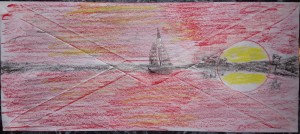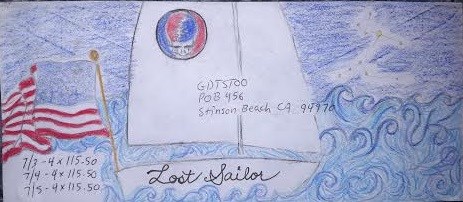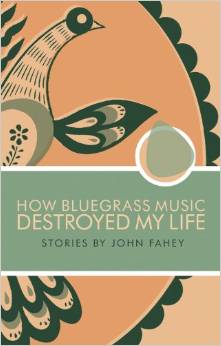(and a Friday, and a Sunday). My manager came into my office on Friday, and said, “I guess I know what YOU’RE doing on July 4.” I didn’t. I hadn’t heard. I had heard that an announcement was coming, but the ripple effect hadn’t quite reached me yet. “What?” Then he told me the Dead had made their announcement.
One last time, three nights at Soldier Field in Chicago. July 3, 4 and 5 of this year. Then that’s it. No more. Final. Nice way to close out fifty years of playing. Not quite as grueling for the band members, who are getting on in years, as a full tour.
Somehow my passion must be infectious, because I got the go ahead at home, and my ticket requests are in the mail! I had Sabina help me with decorating the envelopes, a decades-old Dead tradition. Did you know that there has been a scholarly paper done on Dead fan envelope art? Fascinating. You can check it out here: Uses for Fan Envelopes from the Grateful Dead Archive as Digital and Traditional Primary Research Sources.
 There is a certain “Great Pumpkin” feel to it. You hope that the effort put forth in your envelope decoration will be rewarded with the ticket(s) you seek. The reality is, we don’t know if we’ll get tickets for any of the three nights, much less all three. But today’s the first day for mail-order postmarks, and mine are in there with everyone else’s, so I like to think we’ve at least got a fair shot.
There is a certain “Great Pumpkin” feel to it. You hope that the effort put forth in your envelope decoration will be rewarded with the ticket(s) you seek. The reality is, we don’t know if we’ll get tickets for any of the three nights, much less all three. But today’s the first day for mail-order postmarks, and mine are in there with everyone else’s, so I like to think we’ve at least got a fair shot.
I went, with this same manager, to State College, PA in 2008 to see them at the Change Rocks show. Then I went to two of the shows during the 2009 reunion tour — I took Sophie to see them in Charlottesville, and Eve came up to Philly with me to see them just a few months before the Rectum, errr, Spectrum got demolished.
So yeah. Add that to all the times I saw them in the 80s and 90s (RFK, Cap Centre, Three Rivers Stadium, Madison Square Garden, etc), and yeah. I wouldn’t miss this for the world.

